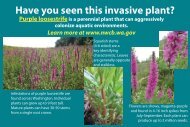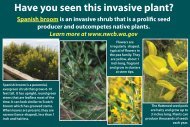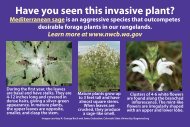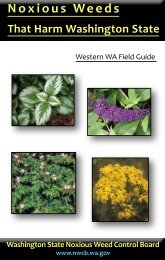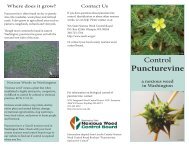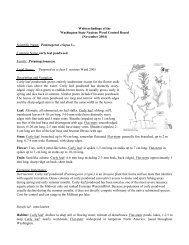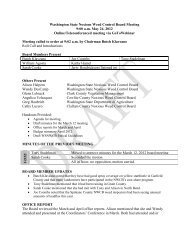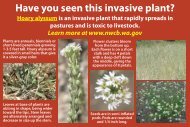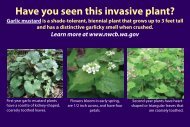Check out our new brochure on noxious weed disposal.
Check out our new brochure on noxious weed disposal.
Check out our new brochure on noxious weed disposal.
- No tags were found...
Create successful ePaper yourself
Turn your PDF publications into a flip-book with our unique Google optimized e-Paper software.
Disposing <strong>noxious</strong> <strong>weed</strong>materialC<strong>on</strong>trolling<strong>noxious</strong> <strong>weed</strong>scan generatesmall to largeamounts ofplant material.Properlymanaging andhandling this material, as well as soil thatmay c<strong>on</strong>tain roots or seeds, will help preventthe spread and reestablishment of these<strong>noxious</strong> <strong>weed</strong>s. C<strong>on</strong>duct as much <strong>noxious</strong><strong>weed</strong> c<strong>on</strong>trol as possible before plants flowerand develop seed. Also, by c<strong>on</strong>trolling<strong>noxious</strong> <strong>weed</strong>s earlier in the seas<strong>on</strong>, beforethey are finished growing, there will be lessplant material to manage.For questi<strong>on</strong>s ab<str<strong>on</strong>g>out</str<strong>on</strong>g> <strong>disposal</strong> and c<strong>on</strong>trolopti<strong>on</strong>s, c<strong>on</strong>tact y<str<strong>on</strong>g>our</str<strong>on</strong>g> county <strong>noxious</strong> <strong>weed</strong>c<strong>on</strong>trol board for informati<strong>on</strong> and assistancethat is specific to y<str<strong>on</strong>g>our</str<strong>on</strong>g> county. Somecounties have specific <strong>disposal</strong> requirementsor provide financial assistance to residentsdisposing their <strong>noxious</strong> <strong>weed</strong>s.General TechniquesIf plants are flowering, cut and bag flowerswhen possible to prevent seed developmentand dispersal. Seal bags and put them inthe trash. Noxious <strong>weed</strong>s that are treatedwith herbicide may be left in place withsome excepti<strong>on</strong>s (see toxic, <strong>noxious</strong> <strong>weed</strong>informati<strong>on</strong>).Woody and Herbaceous Material:Small amounts of woody plant materialthat do not have seeds and do not spreadvegetatively, can be c<strong>on</strong>trolled by pulling orcutting plants and leaving them <strong>on</strong> site withroots exposed to dry, making a brush pile,chipping or burning. If seeds are present,leave <strong>on</strong> site and pile and cover with a tarp orburn, and m<strong>on</strong>itor the area for <str<strong>on</strong>g>new</str<strong>on</strong>g> plants.For small amounts of herbaceous materialsthat do not have seeds and do not spreadvegetatively, plants can be composted, pulledand bagged, pulledor cut and left <strong>on</strong>site to dry with rootsexposed (as l<strong>on</strong>g asplants are not toxic).For large amounts of material with<str<strong>on</strong>g>out</str<strong>on</strong>g> seeds,pull or cut plants then pile, tarp and m<strong>on</strong>itorthe area for any re-spr<str<strong>on</strong>g>out</str<strong>on</strong>g>ing material.Drying: Plant parts with<str<strong>on</strong>g>out</str<strong>on</strong>g> flowers or seedsthat will not spread vegetatively, can be left<strong>on</strong> the ground and m<strong>on</strong>itored as they dry <str<strong>on</strong>g>out</str<strong>on</strong>g>.Plant parts that d<strong>on</strong>’t have flowers or seeds butmay still spread vegetatively should be left <strong>on</strong>tarps, pavement or other surfaces that preventthem from taking root in the soil.Pile and Tarp: For large amounts, pile plantmaterial <strong>on</strong> sheet of plastic or tarp andsecurely cover with another tarp to preventlight and water from reaching plant parts andto keep plant parts c<strong>on</strong>tained. Leave plantstarped until material is completely dried <str<strong>on</strong>g>out</str<strong>on</strong>g>.Bag and Trash: For toxic plants and smallinfestati<strong>on</strong>s of <strong>noxious</strong> <strong>weed</strong>s, the entire plantcan be removed and sealed into a plastictrash bag and disposed. When possible, allowbagged plants to rot in a sunny locati<strong>on</strong>, thendispose of in regular trash.Municipal Yard Waste: Some city compostfacilities may be hot enough to kill <strong>noxious</strong><strong>weed</strong> material. C<strong>on</strong>tact y<str<strong>on</strong>g>our</str<strong>on</strong>g> local county<strong>noxious</strong> <strong>weed</strong> c<strong>on</strong>trol board or wastemanagement to see if this opti<strong>on</strong> is available.When moving <strong>noxious</strong> <strong>weed</strong>s in a vehiclefor <strong>disposal</strong>, make sure to secure plantmaterial so n<strong>on</strong>e can escape duringtransport. Clean the vehicle and equipmentof any <strong>noxious</strong> <strong>weed</strong>material to preventthe spread of seedsand vegetative parts.Also remember toclean y<str<strong>on</strong>g>our</str<strong>on</strong>g> shoes andclothing of any seeds,plant parts and soilthat may c<strong>on</strong>tain <strong>noxious</strong> <strong>weed</strong> seed andpropagating plant parts.Chipping and Compost: Woody plantsthat do not spread vegetatively can bechipped and left <strong>on</strong> site to compost. Chipbefore plants flower and develop seed.Burning: May be an opti<strong>on</strong>, especially forlarge amounts of plant material. However,burn <strong>on</strong>ly in accordance with all federal,state, and local laws and ordinances andpermits. M<strong>on</strong>itor weather c<strong>on</strong>diti<strong>on</strong>s priorto igniti<strong>on</strong> to avoid hazardous fires. It isnot advisable to burn some plants, such astoxic plants.Thurst<strong>on</strong> County NWCBComposting at HomeMost home compost piles do not get hotenough to kill seeds or plants, so <strong>on</strong>ly add<strong>noxious</strong> <strong>weed</strong>s that do not have flowersor seeds and do not spread vegetatively.Do not home compost toxic plants. Anumber of <str<strong>on</strong>g>our</str<strong>on</strong>g> <strong>noxious</strong> <strong>weed</strong>s can spreadvegetatively by plant fragments. Forexample, roots, stems and leaf parts ofthese species can develop roots and spr<str<strong>on</strong>g>out</str<strong>on</strong>g><str<strong>on</strong>g>new</str<strong>on</strong>g> plants, which can escape compost pilesas well as illegal dump sites and spread int<strong>on</strong>atural areas. Do not put these <strong>noxious</strong> <strong>weed</strong>sin home compost piles. Periodically m<strong>on</strong>itory<str<strong>on</strong>g>our</str<strong>on</strong>g> compost area for any escaping <strong>weed</strong>s.Examples of vegetatively spreading <strong>noxious</strong><strong>weed</strong>s: yellow archangel (Lamiastrumgaleobdol<strong>on</strong>), purple loosestrife (Lythrumsalicaria) yellow iris (Iris pseudacorus),knot<strong>weed</strong>s: Japanese, Bohemian, giant andHimalayan, (Polyg<strong>on</strong>um cuspidatum, P. xbohemicum, P. sachalinense, P. polystachyum)and f<str<strong>on</strong>g>our</str<strong>on</strong>g> selecti<strong>on</strong>s of English ivy (Hederahelix ‘Baltica’, Hedera helix ‘Pittsburgh,and Hedera helix ‘Star’; Hedera hibernica‘Hibernica’).Yellow archangel growing in a natural areafrom illegal yard waste dumping. Cut stemscan form roots at the leaf nodes and quicklygrow and take over a <str<strong>on</strong>g>new</str<strong>on</strong>g> area.



